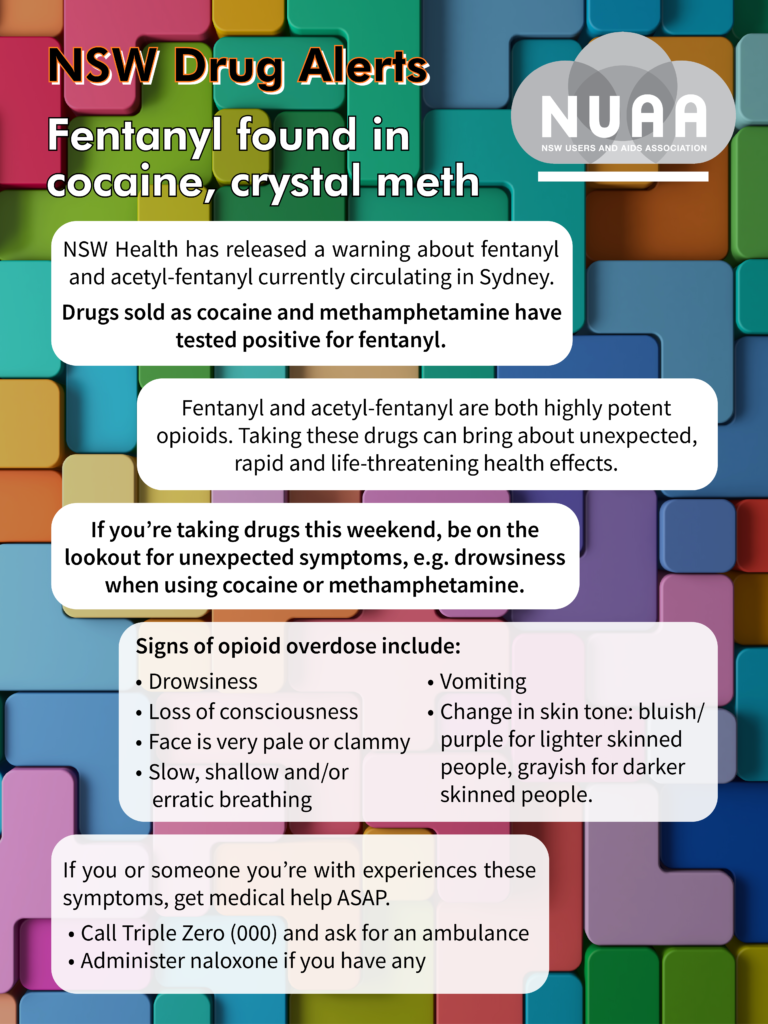Fentanyl alerts and what they mean for you this Mardi Gras
You might have seen some new alerts from NSW Health about a drug called fentanyl, and its relative acetyl-fentanyl. These drugs have been found in some samples of stimulant drugs, like cocaine and methamphetamine, and put users of these drugs at risk of opioid overdose. We’re here to help you understand exactly what this means, what these drugs are, and how you can stay safe this Mardi Gras.
Why is this important?
Fentanyl is a powerful substance. It’s a synthetic (man-made) opioid, a bit like morphine, but about 100 times stronger, and up to 100 times stronger than heroin. When taken unknowingly, and when taken by people who don’t usually use opioids (and who think they’re taking a stimulant) the effects can be harmful, and potentially fatal. Those who take it unknowingly may have less tolerance to opioids and therefore the effects may be more harmful.
Signs and symptoms of fentanyl overdose
Look out for these signs and call 000 immediately if you notice any of these effects:
- Difficulty breathing, e.g. gurgling or snoring sounds
- Slow, shallow breathing
- Hard to wake
- Loss of consciousness
- Drowsiness
- Confusion
- Fainting
- Cold, clammy skin and low body temperature
- Grayish/ashen (in people with darker skin) or bluish (in people with lighter skin) skin, lips or nails
- Tiny pupils
What is fentanyl?
Fentanyl is a very strong narcotic pain medication. It is usually prescribed in the form of slow-release patches to treat severe chronic pain, often for people diagnosed with cancer.
Opioids are a class of drugs that include prescribed painkillers like fentanyl, morphine, and oxycodone, and illicit substances like heroin. Opioids interact with opioid receptors in the brain and elicit a range of responses within the body; from feelings of pain relief, to relaxation, pleasure and contentment. They are depressants, meaning they slow your central nervous and respiratory systems, meaning your breathing and heart rate slow down. Sometimes breathing can slow to the point where you are not able to get enough oxygen to your brain.
Why is fentanyl in cocaine and other stimulants?
Cocaine and other stimulants speed up your central nervous system, while opioids slow it down. There has been a trend in the United States to mix fentanyl into cocaine and other stimulants to create a different high.
How can I avoid fentanyl-related harms this Mardi Gras?
If you want to take cocaine or other stimulants this weekend and avoid the risk of fentanyl-related harms, we have a few tips:
- Check your substances for inconsistences: while fentanyl may appear very similar to cocaine, it is often sold as powder and therefore may stand out if mixed with methamphetamine sold in crystal form.
- Start with small doses and be on the lookout for adverse or unusual effects. Don’t re-dose until you’re sure you’re not experiencing adverse effects. Continue to use in small doses to minimise the risk of harm
- Never dose alone. Always use with friends so you can look out for each other
- Look out for your friends: it’s hard to notice your own symptoms. If a friend feels drowsy, their heart rate and breathing slows considerably, or they lose consciousness, seek help immediately. Be aware of these effects especially if you believe you and your friends have consumed a stimulant. Cocaine and other stimulants speed up your heart rate and central nervous system, so a slowing heart rate is unusual.
- Minimise polydrug use: avoid other depressant drugs, like alcohol, benzodiazepines or other opioids.
- Naloxone is a drug carried by medics and emergency services which is designed to reverse the effects of an opioid overdose. When administered effectively, it saves lives. Always call for help if you suspect a friend is suffering adverse effects from whatever you’ve taken. Naloxone is also available for purchase over the counter at a pharmacy, in a nasal spray (called Nyxoid) and injectable (called Prenoxad)
What to do in case of an overdose
- If you are in a club or at a dance party, attract the attention of medical or security staff, or ACON Rovers. In a private setting or in a location where medical assistance is not available, call 000.
- Get (medical) help immediately if you or someone else experience any overdose symptoms.
- Ask for an ambulance and you will be connected to a control centre for Ambulance NSW. A control centre assistant will ask you a standard set of questions. Answer their questions in a calm and clear manner. Once you have answered all questions, do not hang up the phone, stay on the line and follow any instructions that they give you.
- While you wait for help, put them into the recovery position to facilitate breathing.
- If you have Naloxone and know how to administer it, do so.
Our friends at NUAA have also published some helpful information about how to recognise the signs and symptoms of an opioid overdose and how to respond.

Image courtesy Nothing but bones now. Licensed under a Creative Commons 2.0 Licence.